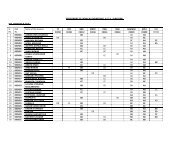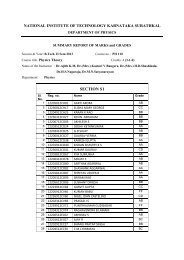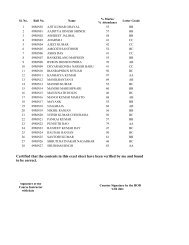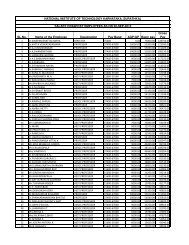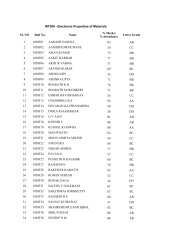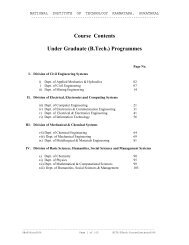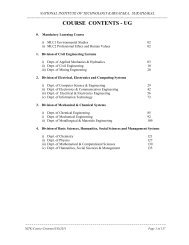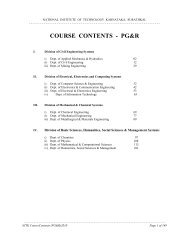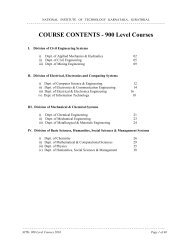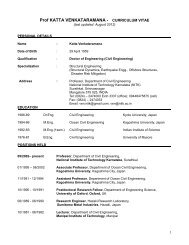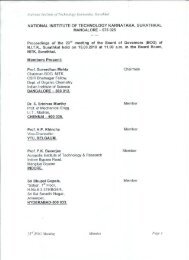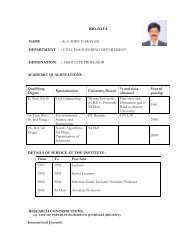course contents - ug - National Institute of Technology Karnataka
course contents - ug - National Institute of Technology Karnataka
course contents - ug - National Institute of Technology Karnataka
You also want an ePaper? Increase the reach of your titles
YUMPU automatically turns print PDFs into web optimized ePapers that Google loves.
NATIONAL INSTITUTE OF TECHNOLOGY KARNATAKA, SURATHAKAL<br />
------------------------------------------------------------------------------------------------------------------<br />
P. H. Gorggins, Unit Processes in Organic Synthesis, 5 th edition, McGraw-Hill, 1958.<br />
J. March, Advanced Organic Chemistry, 3 rd edition, McGraw Hill, New York, 1985.<br />
CY205 ORGANIC CHEMISTRY (3-0- 0) 3<br />
Strengths <strong>of</strong> organic acids and bases. Reagents <strong>of</strong> synthetic importance. Active methylene compounds.<br />
Named organic reactions. Stereochemistry: Optical activity, asymmetric carbon, enantiomers,<br />
diastereomers, configurations and conformations. Carbohydrate chemistry: Monosaccharides,<br />
disaccharides and polysaccharides. Benzene: Structure, aromaticity, Huckel�s rule, electrophilic<br />
substitution and orientation effect. Heterocyclic compounds � five and six membered. Dyes: Colour and<br />
constitution, applications, some important dyes <strong>of</strong> different types.<br />
I. L. Finar, Organic Chemistry, Volume 1: The Fundamental Principles, VI edition, ELBS, 1989.<br />
M. K. Jain and S. C. Sharma, Organic Chemistry, Shoban Lal Chand. & Co., 2000.<br />
CY206 INSTRUMENTAL ANALYSIS LAB. (0–0–4) 2<br />
Potentiometry. Conductometry. Colorimetry. Refractometry. Gravimetric estimations. Demonstration <strong>of</strong><br />
UV and IR spectrophotometer.<br />
A. I.Vogel, A Text Book <strong>of</strong> Quantitative Inorganic Analysis Including Elementary Instrumental Analysis,<br />
ELBS, Longman Group, UK, III Edition, 1962.<br />
J. Basset, R. C. Denny, CH Jaffery and J. Mendhan, Vogel’s Text Book <strong>of</strong> Quantitative Inorganic<br />
Analysis, including elementary analysis, ELBS, London, 5 th Edition, 1989.<br />
CY251 POLYMER SCIENCE AND TECHNOLOGY (3–0–0) 3<br />
Basic concepts, configuration and conformation. Thermoplastic and thermosetting polymers.<br />
Condensation, addition, coordination, ring opening, metathesis polymerization. Copolymerization.<br />
Chemical reactions <strong>of</strong> polymers and polymer degradation. Analysis and testing <strong>of</strong> polymers. Rheology<br />
and mechanical properties: Kinetic theory <strong>of</strong> rubber elasticity, glassy state and glass transition,<br />
mechanical properties, crystalline melting point, property requirements and polymer utilization. Polymer<br />
processing: Molding, extrusion, calendaring, casting, coating, therm<strong>of</strong>orming, foaming. Multipolymer<br />
systems and composites. Additives and Compounding. Fibre and elastomer technology.<br />
F. W. Billmeyer, Textbook <strong>of</strong> Polymer Science, Wiley Interscience Publication, 1984.<br />
Joel R. Fried, Polymer Science and <strong>Technology</strong>, Prentice Hall, NJ, 1995.<br />
CY252 INDUSTRIAL CHEMISTRY (3–0–0) 3<br />
Synthetic Organic Chemical Industries: Petrochemicals � Chemicals from C1, C2, C3, C4 compounds.<br />
Chemicals from aromatics. Phenols and alkyl phenols. Isomerization, Dehydrogenation. Oxidation <strong>of</strong><br />
paraffins. Pesticides and Pharmaceutical Industries. Polymer Industries: PE, PVC, Teflon, SBR, NBR,<br />
Neoprene, Silicone rubber, Nylon, Dacron. Starch and cellulose derivatives. Natural product industries:<br />
Oils. Soaps. Detergents. Essential oils. Paints and Varnishes. Food industries. Fermentation industries.<br />
Explosives and propellants.<br />
E. Riegel, Industrial Chemistry, 6 th ed,, J. A. End, Reinhold Publishing Corp., 1962.<br />
R. N. Shreve, Chemical Process Industries, 3 rd ed., McGraw-Hill Book, 1967.<br />
CY300 INSTRUMENTAL METHODS OF ANALYSIS (3–0–0) 3<br />
Electroanalytical methods: Conductometric and potentiometric titrations. Polarography - theory and<br />
applications. Amperometric titrations. Spectroanalytical methods: Molecular spectra. Beer-Lambert�s<br />
law and its deviations. IR, UV-visible spectroscopy � theory, instrumentation and applications. Atomic<br />
absorption spectroscopy: Thermal methods <strong>of</strong> analysis: TGA, DTA, DTG, instrumentation and<br />
applications. Solvent extraction: Principle, distribution coefficient, separation factor and efficiency,<br />
applications. Chromatography: Paper chromatography, TLC, GC,<br />
HPLC � theory, instrumentation, experimental techniques and applications.<br />
---------------------------------------------------------------------<br />
NITK-Course Contents(UG)2010 Page 119 <strong>of</strong> 134



